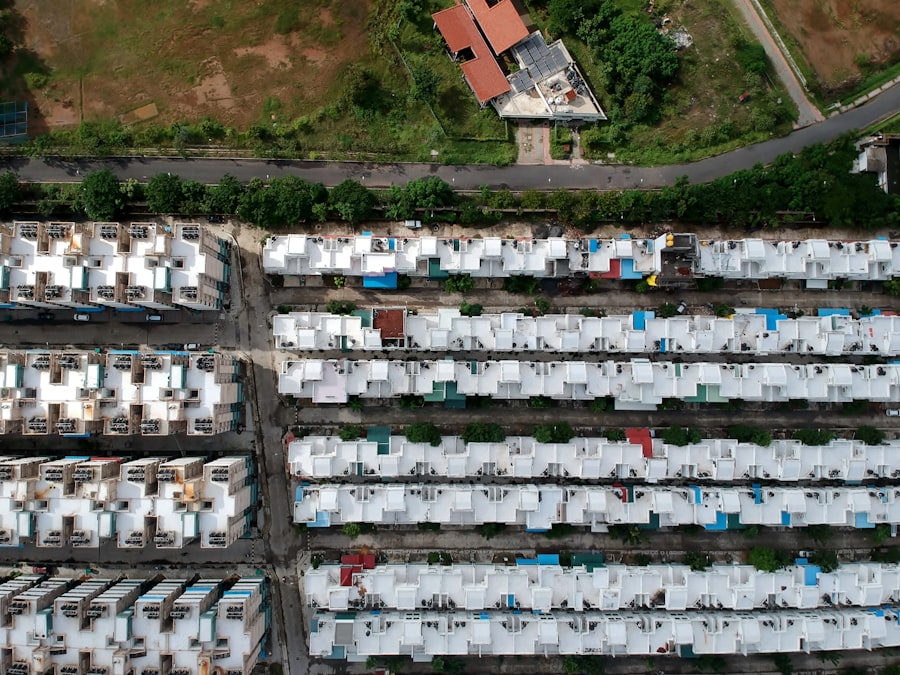As the world increasingly turns its attention to sustainable energy solutions, solar panel installation has emerged as a viable option for multi-family homes. You may find yourself considering the benefits of harnessing solar energy, not just for individual residences but for entire apartment complexes or condominiums. The transition to solar energy can significantly reduce utility costs, lower carbon footprints, and enhance property values.
With the right approach, you can transform your multi-family dwelling into a beacon of sustainability, attracting environmentally conscious tenants and investors alike. The growing interest in renewable energy sources has led to advancements in solar technology, making it more accessible and efficient than ever before. As a property owner or manager, you have the opportunity to capitalize on these advancements.
By installing solar panels on your multi-family property, you can provide your residents with clean energy while also contributing to a greener planet. This article will explore the various challenges and opportunities associated with solar panel installation in multi-family homes, offering insights into how you can navigate this exciting venture.
Key Takeaways
- Solar panel installation for multi-family homes can provide numerous benefits, including cost savings and environmental sustainability.
- Challenges of installing solar panels on multi-family homes include limited roof space, complex ownership structures, and potential resistance from residents.
- Opportunities for solar panel installation on multi-family homes include access to federal and state incentives, as well as the potential for increased property value and tenant satisfaction.
- Overcoming regulatory and permitting hurdles is essential for successful solar panel installation, and may require navigating local building codes and utility regulations.
- Finding the right solar panel system for multi-family homes involves considering factors such as roof orientation, shading, and the energy needs of residents.
Challenges of Installing Solar Panels on Multi-Family Homes
While the benefits of solar panel installation are compelling, you may encounter several challenges specific to multi-family homes. One of the primary hurdles is the complexity of shared ownership and decision-making among residents. Unlike single-family homes, where one owner can make unilateral decisions, multi-family properties often require consensus among multiple stakeholders.
This can lead to disagreements about the installation process, financing options, and the distribution of energy savings. Another significant challenge is the physical limitations of multi-family buildings. You might find that roof space is limited or that the orientation of the building does not lend itself well to solar energy capture.
Additionally, structural concerns may arise, particularly in older buildings that were not designed with solar installations in mind. These factors can complicate the planning and execution of a solar project, requiring careful consideration and potentially additional investment in structural upgrades.
Opportunities for Solar Panel Installation on Multi-Family Homes

Despite these challenges, the opportunities for solar panel installation in multi-family homes are abundant. One of the most significant advantages is the potential for economies of scale. When you install solar panels on a larger property, you can often negotiate better pricing with solar providers due to the increased volume of panels needed.
This can lead to substantial cost savings compared to individual installations on single-family homes. Moreover, multi-family properties can benefit from shared energy systems, such as community solar projects or virtual net metering. These systems allow multiple units to benefit from a single solar installation, making it easier for residents to access renewable energy without needing individual panels on their roofs.
This collaborative approach not only fosters a sense of community among residents but also maximizes the efficiency of energy production and consumption.
Overcoming Regulatory and Permitting Hurdles
Navigating the regulatory landscape is another critical aspect of solar panel installation for multi-family homes. You may find that local laws and regulations vary significantly from one jurisdiction to another, impacting everything from permitting processes to zoning requirements. Understanding these regulations is essential to ensure compliance and avoid costly delays.
To overcome these hurdles, it is advisable to engage with local authorities early in the planning process. You can seek guidance from city planners or zoning boards to clarify any requirements specific to your property type. Additionally, working with experienced solar installation companies can help streamline the permitting process, as they often have established relationships with local officials and a deep understanding of regulatory frameworks.
Finding the Right Solar Panel System for Multi-Family Homes
Selecting the appropriate solar panel system for your multi-family home is crucial for maximizing efficiency and return on investment. You will need to consider factors such as energy consumption patterns, available roof space, and budget constraints when evaluating different systems. It’s essential to conduct a thorough energy audit to determine your building’s energy needs accurately.
You might also explore various financing options available for multi-family solar installations. From traditional loans to power purchase agreements (PPAs) and leasing options, there are numerous ways to fund your project without straining your budget. Consulting with solar experts can help you identify the best system tailored to your specific circumstances while ensuring that you make an informed decision.
Addressing the Cost of Solar Panel Installation for Multi-Family Homes

Government Incentives
Federal tax credits, state rebates, and local incentives can significantly reduce the financial burden associated with solar installations.
Utility Company Support
Additionally, many utility companies offer programs that support renewable energy projects, which can further offset costs.
Affordable Options
By taking advantage of these incentives and exploring financing options like group purchasing agreements or community solar initiatives, you can make solar energy more affordable for your multi-family property.
Maximizing Space and Efficiency in Multi-Family Solar Panel Installations
Space optimization is vital when installing solar panels on multi-family homes. You may need to think creatively about how to utilize available areas effectively. Rooftops are often the first consideration; however, you might also explore other options such as carports or ground-mounted systems if roof space is limited.
In addition to maximizing physical space, enhancing efficiency is equally important. You should consider investing in high-efficiency solar panels that generate more electricity per square foot compared to standard models. Furthermore, incorporating battery storage systems can help you store excess energy generated during peak sunlight hours for use during cloudy days or nighttime, ensuring that your residents have access to reliable power at all times.
Engaging Residents in the Solar Panel Installation Process
Engaging residents in the solar panel installation process is crucial for fostering support and enthusiasm for the project. You may want to hold informational meetings or workshops to educate residents about the benefits of solar energy and how it will impact their living environment positively. By involving them in discussions about financing options and potential savings, you can create a sense of ownership and investment in the project.
Additionally, consider forming a resident committee dedicated to overseeing the installation process. This committee can serve as a liaison between residents and contractors, ensuring that everyone’s concerns are addressed and that communication remains open throughout the project. By actively involving residents in decision-making, you can build a stronger community while promoting a shared commitment to sustainability.
Maintenance and Monitoring of Solar Panels in Multi-Family Homes
Once your solar panels are installed, ongoing maintenance and monitoring are essential to ensure optimal performance over time. You may need to establish a regular maintenance schedule that includes cleaning panels, inspecting wiring, and checking inverter functionality. This proactive approach will help prevent issues that could lead to decreased efficiency or costly repairs down the line.
Monitoring systems are also invaluable for tracking energy production and consumption patterns. Many modern solar installations come equipped with monitoring software that allows you to view real-time data on energy generation and usage. By analyzing this data, you can identify trends and make informed decisions about energy management within your multi-family property.
Case Studies of Successful Solar Panel Installations in Multi-Family Homes
Examining successful case studies can provide valuable insights into best practices for solar panel installation in multi-family homes. For instance, consider a large apartment complex that implemented a community solar program allowing residents to benefit from shared energy production without needing individual panels on their roofs. This approach not only reduced costs but also fostered a sense of community among residents who were invested in sustainability.
Another example might involve a condominium association that collaborated with a local solar provider to install high-efficiency panels on their rooftop. By leveraging available incentives and financing options, they were able to significantly reduce their energy bills while increasing property value. These case studies illustrate how thoughtful planning and collaboration can lead to successful outcomes in multi-family solar installations.
Conclusion and Future Outlook for Solar Panel Installation in Multi-Family Homes
As you consider the future of solar panel installation in multi-family homes, it’s clear that this trend is poised for growth. With increasing awareness of climate change and rising energy costs, more property owners are recognizing the value of renewable energy solutions. The advancements in technology and financing options make it easier than ever for multi-family properties to transition to solar power.
Looking ahead, you can expect continued innovation in solar technology and an expansion of supportive policies at local, state, and federal levels. As more communities embrace sustainable practices, investing in solar energy will not only benefit your property but also contribute positively to the environment and society as a whole. By taking proactive steps now, you can position your multi-family home as a leader in sustainability while reaping the rewards of clean energy for years to come.
Solar panel installation for multi-family homes presents unique challenges and opportunities for homeowners looking to harness the power of renewable energy. One related article that delves into the benefits of solar energy in various applications, including solar thermal energy, can be found here. This article explores the different ways in which solar energy can be utilized, highlighting the potential for cost savings and environmental sustainability. Additionally, for those interested in maximizing space and efficiency, carport solar systems offer a practical solution for multi-family homes. More information on carport solar systems can be found here. Lastly, for investors looking to capitalize on the growing demand for solar energy, exploring solar energy company stocks may provide a lucrative opportunity.
FAQs
What are the challenges of installing solar panels on multi-family homes?
Installing solar panels on multi-family homes can be challenging due to limited roof space, complex ownership structures, and the need to coordinate with multiple residents.
What are the opportunities for installing solar panels on multi-family homes?
Installing solar panels on multi-family homes can provide opportunities for cost savings, energy independence, and environmental sustainability for the entire community.
How can ownership structures affect the installation of solar panels on multi-family homes?
Ownership structures can affect the installation of solar panels on multi-family homes by requiring coordination between individual unit owners, property management, and homeowner associations.
What are some potential solutions for overcoming the challenges of installing solar panels on multi-family homes?
Potential solutions for overcoming the challenges of installing solar panels on multi-family homes include community solar programs, virtual net metering, and innovative financing options.
What are the benefits of installing solar panels on multi-family homes?
The benefits of installing solar panels on multi-family homes include reduced energy costs, increased property value, and a positive impact on the environment.